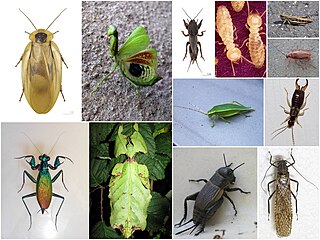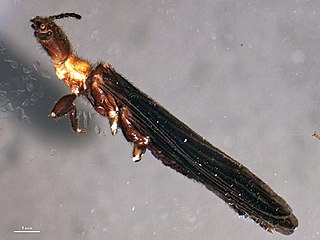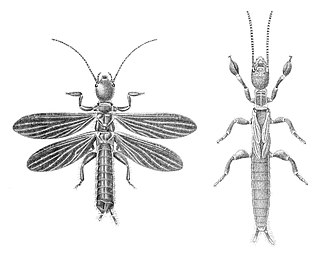
The order Embioptera, commonly known as webspinners or footspinners, are a small group of mostly tropical and subtropical insects, classified under the subclass Pterygota. The order has also been called Embiodea or Embiidina. More than 400 species in 11 families have been described, the oldest known fossils of the group being from the mid-Jurassic. Species are very similar in appearance, having long, flexible bodies, short legs, and only males having wings.
Anisembiidae is a family of insects in the order Embioptera, the web-spinners. The family is divided into several subfamilies. It is the largest family of webspinners.
Edward Shearman Ross was an American entomologist. He majored in entomology at the University of California, Berkeley. Before his PhD was conferred, he worked as curator of insects at the California Academy of Sciences. He wrote many scientific and popular articles about the biology of the insects.

The cohort Polyneoptera is a proposed taxonomic ranking for the Orthoptera and all other neopteran insects believed to be more closely related to Orthoptera than to any other insect orders. They were formerly grouped together with the Palaeoptera and Paraneoptera as the Hemimetabola or Exopterygota on the grounds that they have no metamorphosis, the wings gradually developing externally throughout the nymphal stages.

Haploembia solieri or bicolored webspinner is a species of webspinner in the family Oligotomidae. It is found in Europe, Northern Asia, and North America. Unlike Haploembia tarsalis, which reproduces asexually, H. solieri reproduces sexually. Adult specimens of H. solieri are orange and black and around 11 mm long.
Hesperotingis fuscata is a species of lace bug in the family Tingidae. It is found in North America.

Haploembia is a genus of webspinners in the family Oligotomidae. There are at least three described species in Haploembia. They are native to the Mediterranean, but have been observed in the western United States, and are adventive elsewhere.

Oligotomidae is a family of webspinners in the order Embioptera. There are about 6 genera and at least 40 described species in Oligotomidae.
Hesperotingis is a genus of lace bugs in the family Tingidae. There are about eight described species in Hesperotingis.
Abdastartus is a genus of lace bugs in the family Tingidae. There are about five described species in Abdastartus.
Diradius is a genus of webspinners in the family Teratembiidae. There are about 15 described species in Diradius.

Austroperlidae is a family of stoneflies in the order Plecoptera. There are about 10 genera and 15 described species in Austroperlidae.
Andesembiidae is a family of webspinners in the order Embioptera. There are at least two genera and about seven described species in Andesembiidae.
Archembiidae is a family of webspinners in the order Embioptera. There are at least 2 genera and about 12 described species in Archembiidae.

Clothodidae is a family of webspinners in the order Embioptera. There are about 8 genera and 25 described species in Clothodidae.

Embiidae is a family of webspinners in the order Embioptera. There are more than 20 genera and 80 described species in Embiidae.
Paedembiidae is a family of webspinners in the order Embioptera. There are at least three genera and three described species in Paedembiidae.
Scelembiidae is a family of webspinners in the order Embioptera. There are about 16 genera and more than 40 described species in Scelembiidae.
Sinembiidae is an extinct family of webspinners in the order Embioptera. There are at least two genera and two described species in Sinembiidae.






